2020 Subaru Outback vs. 2019 Honda Passport: Which Is the Better Mid-Size SUV?
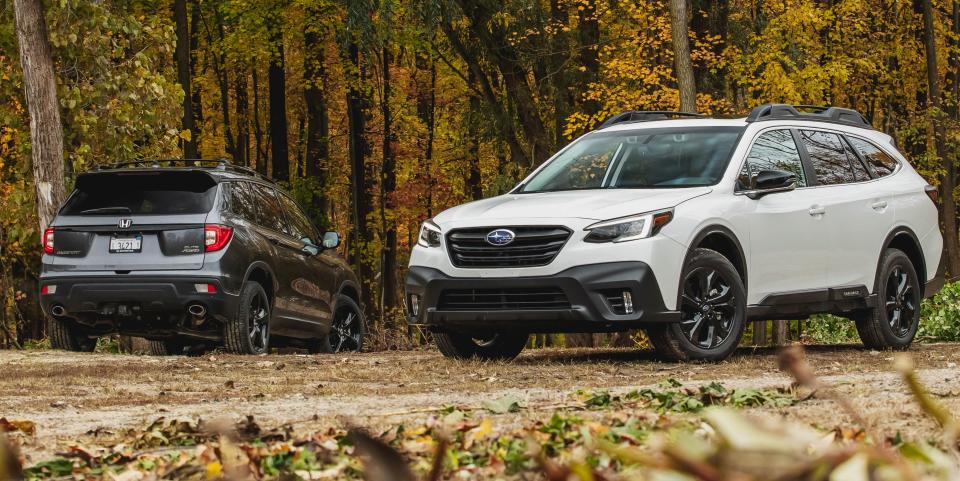

Americans continue to avoid traditional station wagons like an infectious disease, yet they buy the lifted, long-roof Subaru Outback at a considerable clip—roughly 152,000 of the things so far this year. Since Subaru doesn't offer a true mid-size crossover between its compact Forester and three-row Ascent models, it's up to the Subaru Legacy-based Outback, with its raised suspension, standard all-wheel drive, and adventurous go-anywhere marketing, to take on a long list of five-passenger SUVs of similar size. Vehicles such as the 2019 Honda Passport, a shorter and more wieldy version of the three-row Honda Pilot.
The Matchup
Before your start squawking about this being a mismatch, that the Honda is much larger than the Subaru, check the numbers. Dimensionally, these two actually line up quite well. Although the Passport is wider and has a nearly a three-inch longer wheelbase than the redesigned-for-2020 Outback, the Subaru is about an inch longer overall than the Passport. They also match up well under the hood, with the Subaru's optional turbocharged 2.4-liter flat-four making 260 horsepower and 277 lb-ft of torque. The Honda's sole engine choice, a 3.5-liter V-6, puts out a stout 280 horses but only 262 lb-ft.

While both vehicles also cost about the same when similarly equipped, a wide range of trim levels can muddle their tit-for-tat similarities. The Outback's base price is $27,655, with power coming from 2.5-liter flat-four that churns out just 182 horsepower. If you want the turbocharged engine you have to step up to the first of three XT trim levels, which start at $35,905. With options, our turbocharged Outback Onyx Edition XT cost $37,750, but it is possible to configure an Outback to more than $41K. Pricing for the Honda Passport starts at $33,085 in front-wheel-drive form. The least expensive all-wheel-drive model, the Sport, lists for $34,985. Our top-of-the-line Passport AWD Elite cost $44,775.
On the Road
Although the 4255-pound Passport outweighs the Outback by more than 300 pounds, the two accelerate nearly door handle to door handle. The Honda hits 60 mph in 6.1 seconds and pushes through the quarter-mile in 14.7 seconds at 95 mph. The Subaru needs 6.3 seconds to reach 60 mph and does the quarter-mile in a similar 14.8 seconds at 96 mph. These both are rather quick crossovers, but in the real world, the Passport feels a bit more responsive and sportier than the Subaru for two reasons.
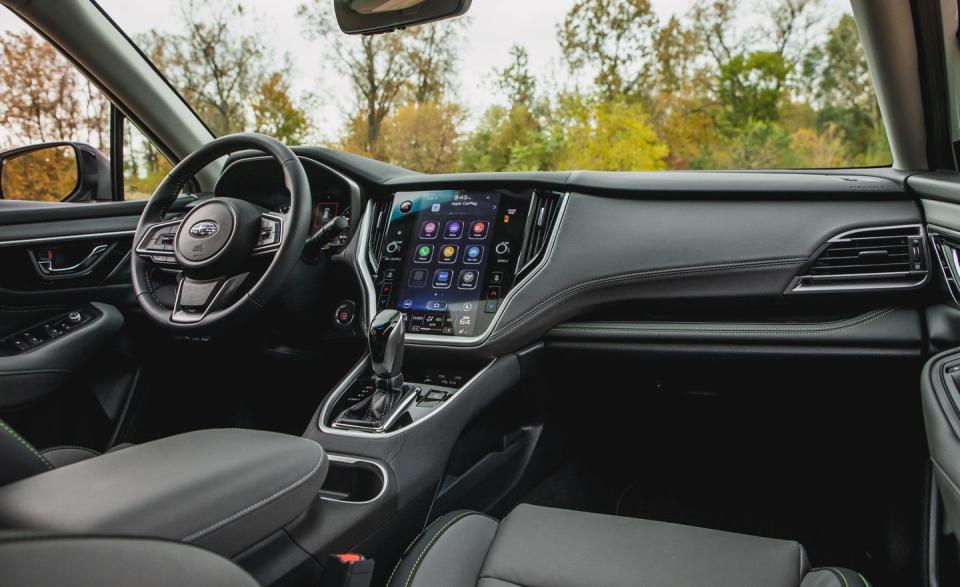
Although we appreciate the off-the-line punch of the Outback's boosted boxer engine, the Honda's V-6 revs more freely and up to 6750 rpm, whereas the Subaru peters out at 6000 revs. We also prefer the Honda's nine-speed automatic transmission, which shifts sharply yet smoothly and always is eager to deliver a downshift when you ask for a burst of power, especially in its Sport drive mode. The Subaru's continuously variable transmission (CVT) may be one of the best of its kind that we've driven, but it's still a bit lazy in comparison to a conventional automatic with a torque converter.
Now built on Subaru's Global Platform, the 2020 Outback feels more solid and refined than it used to. Like the Passport, it's quiet inside, but it rides smoother than the Honda, which allows more road surface chatter to infiltrate its cabin. If pure isolation is what you're after, you'll be happier in the Subaru. The Passport is roughly six inches wider and taller than the Outback, and it feels larger on the road. Yet, it's actually more fun to push on twisty roads than the Subaru. Both SUVs have a fair amount of body roll, but the Honda feels more engaging, and its slightly heavier steering delivers more feedback to its driver. At the test track, the dynamics of both vehicles were pretty close. Despite our Outback test car rolling on 18-inch wheels and Yokohama Avid GT all-season tires versus the Honda's 20-inch Continental CrossContact LX Sport all-seasons, both vehicles generated the same modest 0.78 g of grip on the skidpad. The much lighter Subaru's 176-foot stopping distance from 70 mph, unsurprisingly, was eight feet shorter than the Honda's.
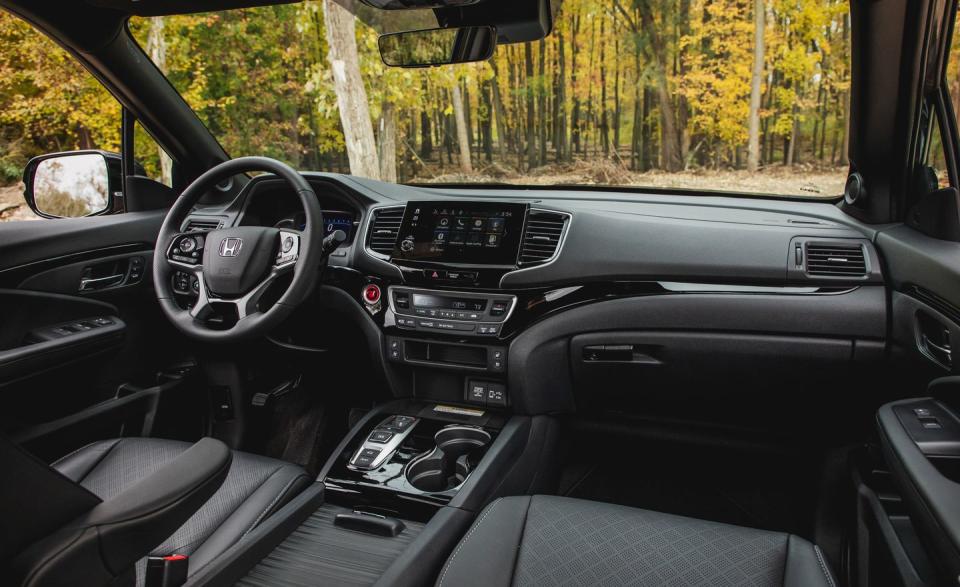
Neither of these crossovers is ready for the Rubicon Trail. There are no low-range transfer cases, locking differentials, or meaningful skid plates to be had here. Anything more than light two-tracks are sure to max out their off-road capability. The Passport does sit a couple of inches higher than a Pilot, and it has better approach and departure angles than the Outback, but its 8.1 inches of ground clearance actually is a half-inch less then you get beneath the Subaru.
Fuel economy also goes to the Outback, with the EPA giving it a combined estimate of 29 mpg with its base engine and 26 mpg with the turbo mill. In comparison, the Passport carries an official 21-mpg combined rating with all-wheel drive; add 1 mpg for front-drive versions. On our 75-mph highway fuel-economy test, however, the Subie's 28-mpg result was 2 mpg less than its EPA highway estimate and only marginally better than the Honda's 27 mpg, which topped its federal highway figure by a solid 3 mpg.
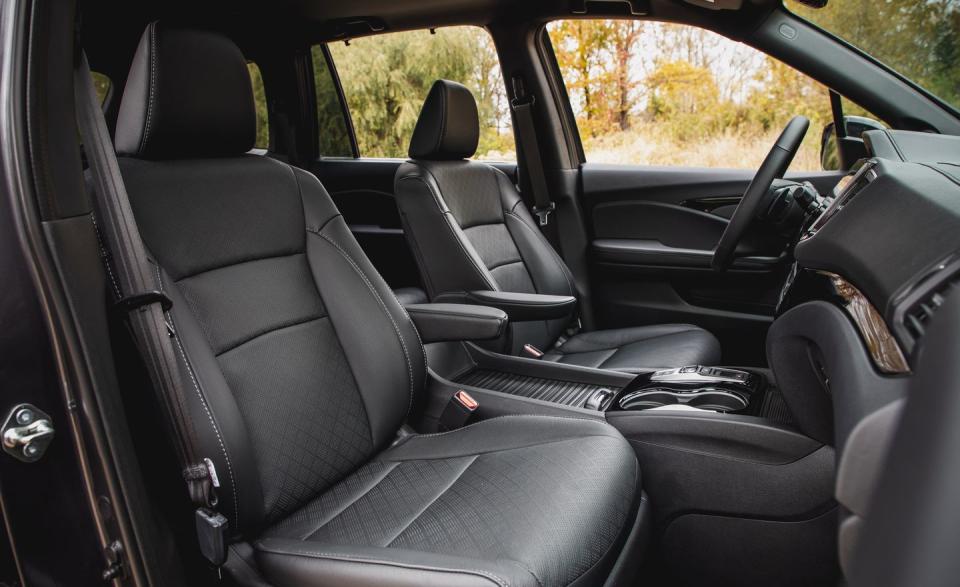
The Inside View
If you crave the wide-open cabin expanse of a true mid-size SUV, you want the Passport. It offers significantly more front-seat elbow and headroom than the Subaru. The Outback doesn't feel cramped, but it offers essentially the same interior accommodations as the Legacy sedan, which means it feels more like a car. The Honda's back seat isn't radically more spacious than the Subaru's, but its additional width makes it more tolerable for three-abreast seating. It's also more comfortable, with softer seat padding and a seat back that reclines. Both our test cars' rear quarters were heated, with rear climate system vents and a couple of USB ports, but the Honda also sports six cupholders to the Subaru's two. With 41 cubic feet of space behind its rear seat, the Passport easily wins the cargo-volume contest over the Outback and its 33 cubes of space. However, the gap narrows with their second rows folded flat: 76 cubic feet for the Subaru to 78 for the Honda.
Up front, we prefer the softer padding of the Subaru's front seats, the cleaner design of its gauges, and its traditional shift lever. The Honda is comfortable and has a similarly high level of build quality, but the Passport's push button shifter is irksome to acclimate to, and its interior feels a bit unadorned for a $44,000 vehicle. There's just too much hard plastic to ignore. The Subaru's massive, vertically oriented 11.6-inch touchscreen interface also dwarfs the Honda's 8.0-inch touchscreen, giving its cabin a more modern look and feel. Unfortunately, that screen is a bit slow to respond to inputs, and its overall presentation of information could be better.
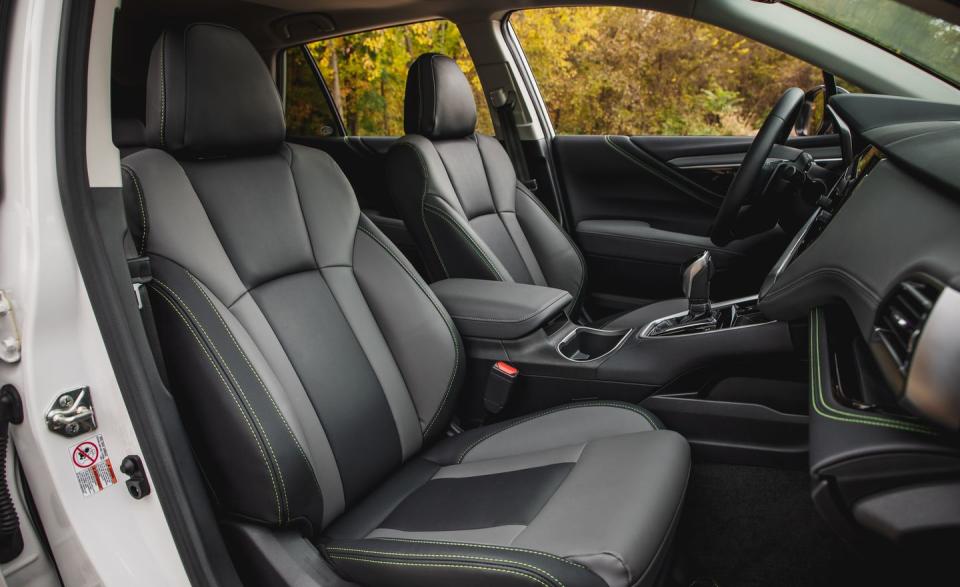
The Bottom Line
If absolute space is what you seek, we happily recommend the Honda Passport. It is a comparison-test winner after all, bettering a raft of its peers that included the Chevrolet Blazer, Ford Edge, Hyundai Santa Fe, and the Nissan Murano. After several days of driving that group, we concluded that the Passport offered the best combination of utility and driving pleasure for a reasonable price. That's still the case.
Yet, if you don't mind a smaller package, the additional value of the less-expensive Subaru is undeniable. The Outback offers the more luxurious interior of the two, standard all-wheel drive, and it equals the Honda's performance when equipped with its available turbo engine. It also matches the Passport feature for feature, and it wears significantly better fuel-economy ratings. Dollar for dollar, Subaru's lifted wagon is the better SUV here.
You Might Also Like

 Yahoo Autos
Yahoo Autos 